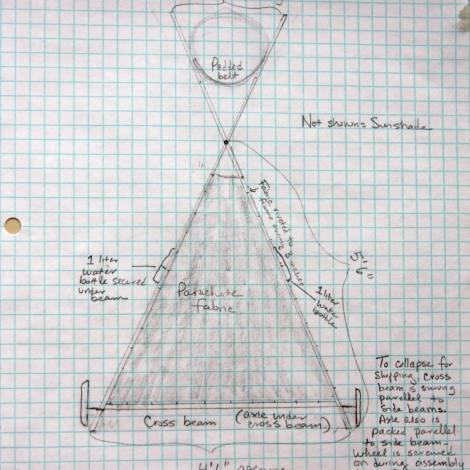
Chase Lewis demos his prototype travois design made from substituted materials that he had at hand. The device could help refugees carry their children on the long trek from their homes to camps. Photo courtesy of Chase Lewis.
Chase Lewis, age 12, has designed a life-saving device that refugees can use to carry children on the trek from their homes to camps. Lewis drew and built a prototype of a wheeled travois, his update on a prehistoric technology. The travois, a kind of triangular cart, attaches to the user’s waist with a belt, allowing him or her to walk with a cargo behind. Built around parachute cloth, Lewis’ travois is designed for air drops. To ensure its feasibility, Lewis now seeks technical advice from more experienced engineers.
If he can make his design practical, Lewis plans to enter it in the Young Scientist Challenge 2012 contest by 3M and Discovery Education before the entry deadline of April 19. “It’s a time-tested design that’s been proven hundreds of times by Indians and soldiers in the Civil War,” Lewis told E4C.
The travois is Lewis’ response to a grim problem that afflicted Somali families as they walked to distant refugee camps during last year’s drought and famine. Crippled with thirst and hunger, parents could not carry all of their children who were too exhausted to walk. They left hundreds of children to die on the side of the road, in some cases forced to choose which of their children to leave and which to carry on.

The first drawing of the device, a sketch on graph paper. Image by Chase Lewis
Design features
Lewis’ travois makes multiple uses of its parts. First, he figures that relief workers could air-drop the device to the refugees en route. They would land as bundles of parts for dozens of travois with water bottles, tools and assembly instructions. Parachute cloth could be cut and slung between the side poles as the load-carrying platform. Lewis gave us a run-down of the device’s other features.
*It’s a two-wheeled design for use in desert conditions without much clogging of the axles
*It can be folded, airlifted and easily assembled
*It’s designed to transport humans, specifically
*It can double as a bed
*It might come with a map and two bottles of water
*The belt attachment method allows women to carry babies in cloth slings on their backs while also pulling the travois.
The last point is interesting. Lewis’ mother and younger sister work with ABAN, a non-profit in Accra, Ghana, that aids impoverished girls. Women in Accra often carry their children on their backs in cloth slings, his family told him. Lewis figured that women in other parts of Africa and the world might do the same, so he opted for the belt, rather than a backpack or over-the-shoulder strap, to avoid interference.
Materials
*Parachute fabric
*1.5 by 1 by 8ft white board
*1.5 by 1 by 4.5 white board
*1in-diameter aluminum bar
*8in-diameter wheels (maybe bigger), fit to go on axle
*1in bolt wing nut that fits on bolt
*1.5 by 2 by 6 white board
*Four bolts 4in long
*Four wing nuts that fit on 4in bolts
*Padded belt, 4in wide
Technical questions
These are the questions Lewis has about his device’s functionality.
*How much weight would rest on the hips, assuming 70 pounds of human cargo?
*Could the parachute fabric rip if secured with rivets (and weighted down by a squirming kid). “I doubt the fabric would rip, considering I would put one rivet every three inches and it would spread out the weight,” Lewis says.
*Is whiteboard an appropriate material – will it bend or break too easily? “I might end up going and buying a plank of whiteboard and doing a strength experiment,” Lewis says. “It is possible that PVC pipes would be more practical.”
*What size and type of wheel would be best for the dirt roads in Africa?
*I also have to figure out the best way to have it all collapse. “I’m thinking I might have to build a full-scale model and figure it all out. One thing’s for certain, the axle is going to come out,” Lewis says.

This technical draft of the device is based on Lewi’s sketch and written description. See a larger version here (pdf). Image by Kerry White
The prototype
Shortly after speaking with us, Lewis spent a day making a rough prototype from materials he had at hand: paper instead of parachute fabric, velcro instead of joints and rivets, a bathrobe belt instead of a backpack belt, and 8in-diameter wheels instead of 10in or 12in wheels.
“I put this together to give your readers a sense of what the design would look like and to give myself a sense of how practical the travois would be. I was pleased when I put on the belt and confirmed that the basic design would work and that not much weight was actually distributed onto the bearer (in this case, onto me),” Lewis told us by email.
The designer, a bio
After noting the details of his design, we asked Lewis the obvious question about whether he’d like to go into an engineering field as a career. “I have no idea what I’m going to do with my life. I haven’t made up my mind on that yet,” he says. But he’s sure he will start his professional life by making a movie. His talents are enviable and eclectic: This year his experiments on the combustion of nitrocellulose in proportion to the tightness of the textiles’ weaves will compete in North Carolina’s state science fair. He also shoots stop-motion video shorts with Lego figures (that sometimes include firecrackers), and he designs “all sorts of stuff on the computer.”
[quote]“When you called, I was making a virtual model of an alien solar system. Similar to ours.”[/quote]
Contact
Lewis has offered his mother’s email address for those who would like to offer technical comments on his travois design. Please write to this email:

Related resources
Lewis’ Travois design presentation (Power Point)
Travois draft (pdf)


I just started as the STEM Education Advisor for Brilliant Star Magazine and I ran across this article. I tried to contact Chase to see if there were any developments since it was published to see if it would be worthwhile to highlight his innovation in the online version of the magazine, but his email address is no longer valid. Do you have another way to contact him?
I might be able to help. I posted an update a couple of years after this article and you can see it here: https://www.engineeringforchange.org/news/a-teenage-inventor-upgrades-emergency-rescue-technology/
And Chase (now Alexis) Lewis has a website with contact info here: https://www.alexislewisinventor.me/contact
If you post something I’d love to see it if you wouldn’t mind sending the link. Good luck!